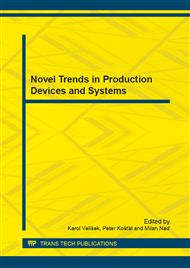p.67
p.73
p.79
p.85
p.91
p.97
p.103
p.109
p.115
Material Flow Design Supported by Simulation Methods
Abstract:
Design solution of material flows planning in manufacturing systems belongs to key aspects that the project engineers must resolute. The conception and technical material flow realisation considerable define the dependability, promptness, consistence and next needed flows of work in the material flow. These necessary material flow functions influence the production quality, the amounts of production costs and the producer profitability. Follow up is starting to use the simulation methods at material flow designs and innovations. These methods are used in verification of new designs of material flows or in validation of just realised material flows. There is possibility of verification and validation usage by software Witness. Witness software simulation offers an optimal solution of problems by means. It enables to simulate working environment as well as material flows. The result is the higher efficiency of whole process and elimination of problems.
Info:
Periodical:
Pages:
91-96
Citation:
Online since:
January 2014
Authors:
Keywords:
Price:
Сopyright:
© 2014 Trans Tech Publications Ltd. All Rights Reserved
Share:
Citation:


